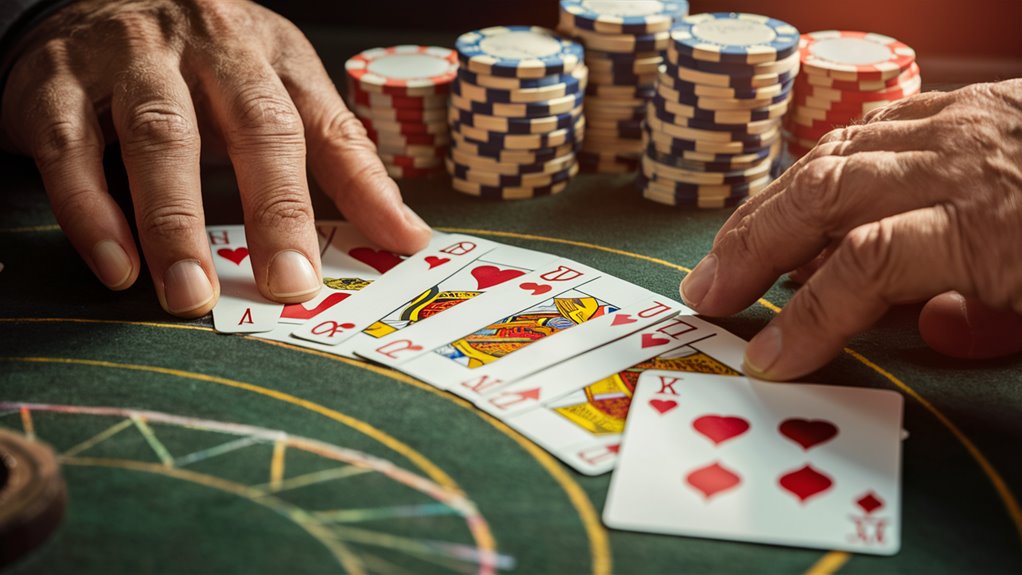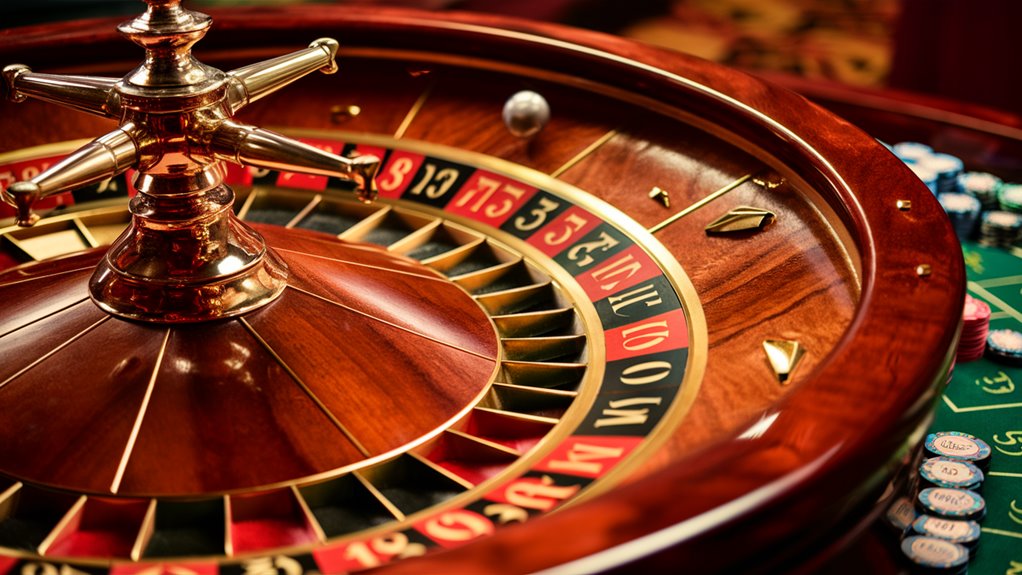Win Big at Poker: Your Guide to Consistent Wins

Get the Basics Right
Turn your random poker games into money-making plays by nailing the basics. Knowing hand ranks and position play is key for long-term wins. Figure out exact pot odds for each move to up your expected value. 이 내용을 꼭 확인해보세요
Bankroll Management Basics
Use tight bankroll management tactics to guard your cash. Stick to the 5% rule – never bet more than 5% of your whole bankroll per game. Keep at least 20 buy-ins for your game level to handle ups and downs well.
Grow Your Strategy
Watch how your rivals play through careful study and build tilt resistance with strict training practices. Keep detailed stats in tracking sheets to spot weak spots and chances. Change your plan based on hard data, not feelings.
Play Mind Games
Use advanced mental tricks to get ahead of your rivals. Be a pro at shaping table image and betting styles that confuse others while you gain more. Get good at timing tells to get the most from tight spots.
Key Tools for Winning
- Hand tracking apps for deep checks
- Charts showing best start hands based on position
- Odds tools for tricky spots
- Variance tools for bankroll plans
- Note systems for player-driven plays
Blend these elements into a strong winning plan to move past break-even players and keep making money at the tables.
Know Your Poker Hands Well
Full Guide to Poker Hand Ranks
Know Poker Hand Ranks Well
Poker hand ranks are the core of a winning poker strategy. Knowing these ranks well is key for tough play and smart game moves.
Top Hand Ranks
Royal Flush
The best poker hand blends Ace through 10 of the same suit—this is the top combo in poker.
Straight Flush
Five straight cards of the same suit make this strong combo, just behind the Royal Flush.
Four of a Kind
This top holding has all four cards of the same rank, plus any fifth card.
Mid-Level Hand Ranks
Full House
A classic combo that matches three cards of one rank with two of another.
Flush
Five cards of the same suit make this strong hand, no need for order.
Straight
Five cards in order, any suits, make this useful combo.
Common Hand Ranks
Three of a Kind
Three cards of the same rank make this common combo.
Two Pair
Two groups of matching pairs, plus an odd card out.
One Pair
Two cards match in rank for this simple hand.
High Card
If no combo works out, the top single card calls the shots.
Fast Choices
Knowing hand ranks well lets you make quick moves in fast games. Players must spot and weigh these combos fast to keep their edge at the poker table.
Crucial Poker Math
Key Poker Math: A Complete Guide
Get Poker Math Right
Poker math is key to making money moves at the table. Winning at poker means nailing three big math ideas: pot odds, implied odds, and expected value (EV). These key numbers guide smart bets and long-term cash wins.
Figuring Pot Odds
Pot odds math is basic for making smart call choices. To find pot odds:
- Divide the call amount by the whole pot size (counting your call)
- Show the result as a ratio
For instance, facing a $20 call into a $100 pot makes pot odds of 20:120 (simplified to 1:6). Line these odds up with your win odds to spot money-making calls. When your win chances beat the pot odds, you’ve found a math-backed call.
Nail Expected Value (EV)
Expected value checks nail down the long-term cash value of poker moves. The EV math:
– (Win Odds × Cash Win) – (Loss Odds × Cash Loss)
Example math:
- 40% chance to win $100
- 60% chance to lose $50
- EV = (0.4 × $100) – (0.6 × $50) = $40 – $30 = $10
A positive EV means long-term money wins while a negative EV says skip the play. Regular EV checks boost smart choices and grow win rates over time.
Spot Opponent Moves
Read Opponent Moves Well: A Full Guide
See Body Moves and Usual Acts
Body tells show hand strength and player sureness at the poker table. Watch close for unplanned acts like shaky hands, fast breaths, or throat clears—they often tell if players have top hands or just bluff.
Set a base read of each player’s usual act in calm times. Key things to watch:
- How they stack chips
- Natural sitting ways
- How they usually talk
- Their normal bet moves
See Patterns in Bets and Timing
Bet Pattern Checks
Bet styles give clues about hand power. Note acts like:
- Usual preflop raise sizes
- Bet sizes after the flop
- How often they bet after the flop
- River bet-to-pot sizes
When players change from usual patterns, like a raise from 3x to 5x, it often means they hold strong hands.
Timing Tells and Choices
Timing tells are solid clues of hand power. Look for:
- Very quick moves
- Slow choice times
- Usual bet rhythms
- Odd timing changes
These timing shifts often mean set choices based on hand power. Mix these behavior reads with math odds and spot know-how to max your table edge.
Play Positions Well
Win with Poker Positions

Get Position Wins
Position play is key to winning poker, giving clear edges in both hand picks and choices after the flop. Late spots give big edges by letting players see others’ moves first. The button and cutoff spots let you choose more hands and control the pot better.
Start from Early Positions
Early spot play needs tight play and choice hand picks. Pick only top hands from early spots, like strong pairs and good face card mixes. This tough line makes up for the down side of moving first after the flop.
Play the Middle Spots
Middle spots let you play a wider mix of hands. Suited links and middle pairs work when table acts and chip sizes fit well. This moderate edge lets you pick more freely while still playing it smart.
Max Out Choices After the Flop
Post-flop position play deeply impacts if you win cash and make smart choices. In-spot play lets you:
- Get more value with strong hands
- Lose less with so-so hands
- Bet more after the flop
- Read rivals better
Position power is more than just where you sit—it’s a big info edge that shapes every part of the game. Get good at knowing spots to keep making cash from poker.
Handle Your Money Right
Keep Your Poker Cash Safe
Crucial Cash Handling Tips
Smart money handling is the base of lasting poker wins and steady cash gains. Right bankroll handling is more than just having enough to play—it’s a game plan for handling ups and downs while aiming for more wins.
Guidelines for Risk
The key 5% rule is a must: never bet more than 5% of all your cash in one game. For cash game players, keep at least 20 buy-ins for your game level. Example: Playing $1/$2 with $200 buy-ins needs at least $4,000 ready. Tourney players should keep 50 buy-ins due to bigger ups and downs.
Track Your Play
Close tracking through detailed sheets is key for watching:
- Wins/losses
- How much you make an hour
- How you do in different game types
- What game levels work best
This full data view lets players:
- Pick the most money-making game types
- Spot weak spots in strategy
- Decide on game levels
- Place their cash best
Manage Bad Runs
When bad runs happen, use these safe steps:
- Skip chasing losses
- Think about playing at lower stakes for a bit
- Focus on keeping your capital
- Stick to strict cash rules
- Check your play data for tweaks
Sticking to these cash rules builds a strong base for long-term poker wins.
Stay Strong Under Stress
Stay Tough in Tough Games
Grow Top Mental Toughness
Mental toughness is key for making top choices, mainly in tough games where the mental push is huge. Growing top mental strength means handling your feelings while keeping a sharp focus when it counts.
Mind Tips to Stay Sharp
Meditation and Being Mindful
Daily mind practice strengthens mental control and helps keep calm under big pressure. This key method builds the base for smart decision-making by clearing your mind and keeping emotions in check.
Look at Your Performance Right
Smart game checks must be apart from how you feel. Optimizing how you play needs a system of looking over choices, focusing only on game moves, not how they made you feel. This way of checking ensures you keep getting better while playing your best.
Handle Your Feelings
Controlling feelings is key to staying at your best. The 10-second reset is great for hard times: stop, count to ten, and refocus before you move on to the next play.
Keep Track of Your Mental Game
Keep a detailed mind game journal to note down emotional patterns and spot what pushes your buttons. This methodical approach to training your mind pinpoints areas to work on while boosting successful mental moves.
Train for Tough Minds
Growing a shield against tilt—when feelings beat logic—needs regular practice and using these methods. Using these mental training habits builds the mental strength needed for long-time top play.
Smart Bluffing Moves
Smart Bluffs in Poker
Know the Trick of Lying Right
Mental strength is the base for pulling off poker’s trickiest move: smart bluffing. By adding many layers of tricks, players can raise their bluffing beyond simple aggressive bets.
Build Believable Bet Styles
Smart bet sizes build the first layer of tricks. Set up consistent bet styles over many hands with strong cards, then copy these exact styles when bluffing. This planned move makes a strong mental trap, making rivals question even their best guesses. Offering Healthy Options in Casino Restaurants to Appeal to Health-Conscious Gamblers
Grow Your Table Look
How you appear at the table is key for smart bluff pulls. Swap from a tight-aggressive style to showing weaker hands on purpose, creating the perfect cover for later big bluffs. Pick these image-making chances in smaller-stakes games to work best.
Bluff Based on Position
Knowing your spot and checking your rivals sets up top bluff chances. Aim at players who fold more than 65% to follow-up bets for best results. Watch the board closely—unlinked boards far from what rivals likely have are prime times for bluffing.
Use Defense Counts
Nail the art of bluffing based on counts by seeing and using how rivals defend. Focus on how the board looks and mix it with exact timing to build strong bluff stories that get rivals to fold often.


